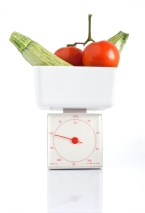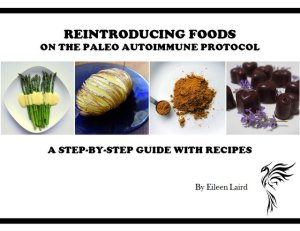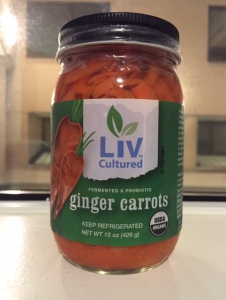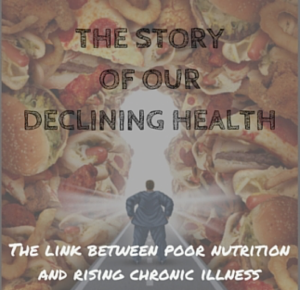
By Rory Linehan
Key Messages:
- Chronic disease in skyrocketing among western populations
- In the US state of Maine alone, chronic disease accounts for 3/4 of all deaths, up from just 1/6 in 1900
- The Agricultural and Industrial Revolutions introduced a raft of highly processed foods to the western diet, including sugars, grains, dairy and refined vegetable oils
- These foods have been shown to provoke an inflammatory response in our bodies, leading to elevated chronic disease
- During the same period, our vegetables have become far less nutritious
- Proper nutrition is essential to good health and can prevent and even reverse chronic illness.
Humans are more populous and are living longer than ever before. In the span of the last 100 years human population has risen over four fold[1]. Since 1900 the global average life expectancy has more than doubled, and is now approaching 70 years[2]. We are achieving significant breakthroughs in medical innovation and technology on a scale never witnessed before, and at first glance, this would suggest that we are healthier than our forebears. But there is more to this story than just first the first glance…
Longevity increasing but chronic disease rising
Across the western world and increasingly in the developing world, chronic disease is skyrocketing. The the US state of Maine alone, three quarters of people die from chronic and mostly preventable disease, an astronomical rise since 1900, where just one in every six people died from chronic illness[3].
There is a rational argument that as the human population lives increasingly longer, one would expect to see a gross increase in disease associated with age, such as chronic disease.
However recent studies are turning that theory on it’s head. A raft of studies are showing that while the total number of people with chronic disease is rising (supporting the theory), so too is the proportion of chronic disease rising in the population[4][5] (debunking the theory).
Why is chronic disease rising?
If you are reading this blog, you may already know that I focus on diet, lifestyle and mindset as the three key pillars to health. As our reliance on technology has increased and we have become busier, we are investing less and less time maintaining these pillars, and the materials (nutrition) we are using to build them are becoming increasingly devoid of the nutrition they need to stay strong. As a result, our health is crumbling around us.
In this series, The Story of our Declining Health, I will document how each of these pillars has contributed to our increasingly poor health. I’ll lay out the rationale in a succinct, easy to follow manner, detailing how we have become ill and what we can do to reverse the trend and reclaim our health.
Today’s post explores the fundamental role poor nutrition has played in the rise of chronic illness.
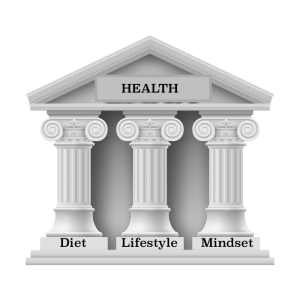
The revolutionary change in our nutrition
To the best of our knowledge, modern humans (Homo Sapiens) first started walking this planet around 200,000 years ago. Even further back, our earliest human ancestors (the Homo Habilis) have been dated to as early as 2.5 million years ago[6]. To put this in context, during this time the saber tooth tiger was still roaming and the gap between north and south America had only just been sealed![7]
The human diet from 2.5 million years ago until just 10,000 years ago would have varied according to geographic location, climate, altitude, etc. However, before the development of agriculture and animal husbandry 10,000 years ago, our diet consisted of minimally processed wild plant and animal foods[8]. The advent of the Agricultural and Industrial Revolutions (representing just 0.4% of humans’ time on this planet) saw a sharp change in the types of food we were consuming, as advanced food-processing procedures were developed. This was particularly pronounced following the Industrial Revolution (ending in the late 1800s in the US and continuing well into the 1900s in other countries[9]).
The western diet following these revolutions was greatly varied to that of our ancestors. Over 72% of the energy received from western diets comes from sources which were not available to our ancestors including dairy, grains, refined sugars, refined vegetable oils and alcohol[10].
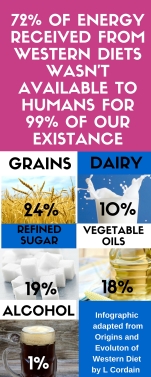
These ingredients provide the basis for food ubiquitous in western diets, including; pizza, cake, bagels, soft drinks and chips. The introduction of these nutrient poor, inflammatory foods have had far reaching effects on our health and wellbeing.
Tying it all together: Poor nutrition = Poor Health
As the foods of the Agricultural and Industrial Revolutions replaced the minimal processed wild plant and animal foods they started to adversely affect human health.
These foods have been shown to provoke inflammatory responses in our bodies, leading to poor health and chronic illness. In his paper “The Origins and Evolution of the Western Diet: Health Implications for the 21st Century”, author Loren Cordain shows the processed foods of the aforementioned Revolutions have adversely impacted the following seven dietary indicators of health:
- Glycemic Load
- Fatty Acid Composition
- Macronutrient Composition
- Micronutrient Density
- Acid-Base Balance
- Sodium-Potassium Ratio
- Fibre Content
At the same time heavily processed foods have replaced plant and animal foods, our modern-day plant foods have become less nutritious. In her book “Eating on the Wild Side” (affiliate link*) author Jo Robinson reveals how humans have bred fruits and vegetables to be larger and sweeter, resulting in a dramatic loss in nutrients.
This has had serious adverse implications on our health as nutrients are needed to repair tissue and muscle damage, quell inflammation and even to properly digest foods. Nutrients also play a critical role in reducing the onset of chronic disease[11], eating ample amounts of nutrients reduces the risk for a raft of chronic disease.

Jo Robison’s Eating on the Wild Side (affiliate link*)
Where to from here?
The food we eat gives our bodies the materials they need to function properly. If we don’t get provide our body with the right materials our health declines. The replacement of wild, nutritious, plant and animal foods with the highly refined and processed foods of the western diet has seen rates chronic disease skyrocket. To reclaim our health, we must provide our bodies with the materials they need to function optimally.
In future posts, I’ll explore a range of different dietary approaches used to provide our body with adequate nutrition and heal from chronic disease. Stay tuned!
* As an affiliate I earn a small commission (at no extra cost to the buyer) on purchases made by clicking on the links above. This commission helps me with the costs associated with maintaining the Paleo PI. I only participate as an affiliate for products and programs which I whole-heartedly endorse
[1] https://www.census.gov/population/international/data/worldpop/table_history.php
[2] http://ourworldindata.org/data/population-growth-vital-statistics/life-expectancy/
[3] http://digitalcommons.library.umaine.edu/cgi/viewcontent.cgi?article=1287&context=mpr
[4] http://www.ncbi.nlm.nih.gov/pubmed/17440120
[5] http://www.ncbi.nlm.nih.gov/pubmed/17440120
[6] http://www.npr.org/sections/13.7/2012/09/11/160934187/for-how-long-have-we-been-human
[7] http://www.bbc.co.uk/nature/history_of_the_earth/Pliocene
[8] http://ajcn.nutrition.org/content/81/2/341.full.pdf+html
[9] http://history-world.org/Industrial%20Intro.htm
[10] http://ajcn.nutrition.org/content/81/2/341.full.pdf+html
[11] http://www.ncbi.nlm.nih.gov/pubmed/12529901
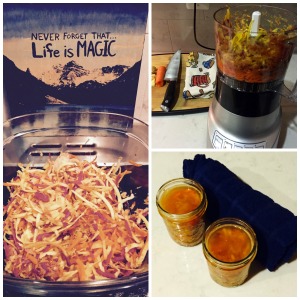

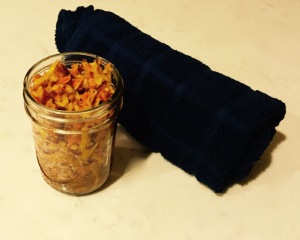




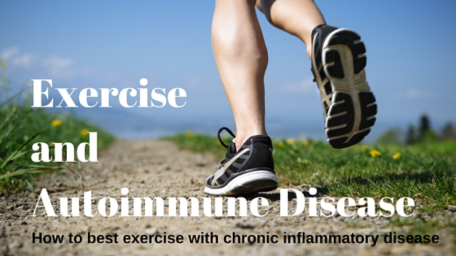 By Rory Linehan
By Rory Linehan


